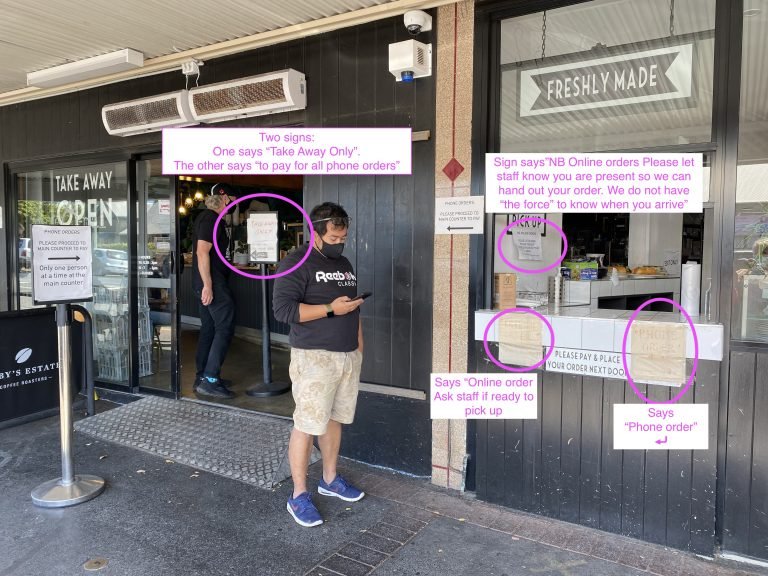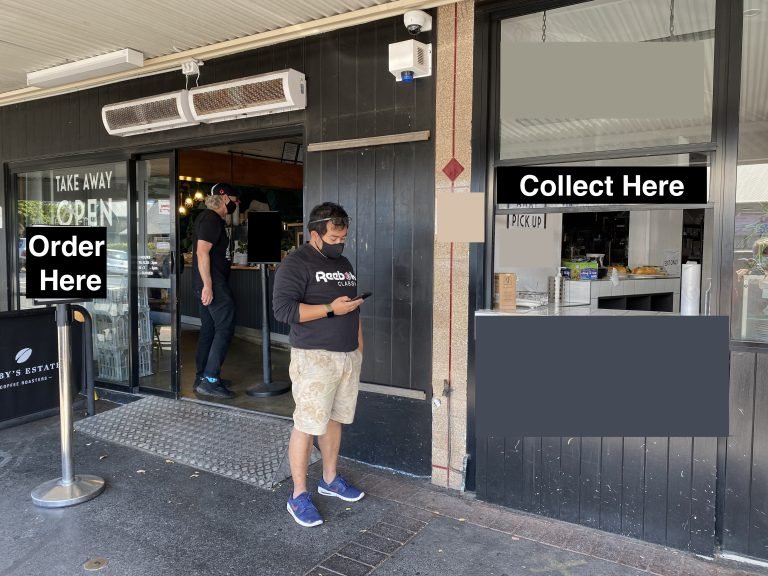Are You Trying To Say Too Much? Here’s How to Streamline Communication.
Are you trying to say too much? Giving out too much information? Having too many calls to action and next steps? Here’s what you need to know if you want to learn how to streamline communication.
On weekends we love grabbing lunch from our local Banh Mi café down the road. It’s super fresh and they have queues down the street almost every day. They do a fabulous job with their food, but when it comes to telling people what they want them to do it can get quite confusing.
There are nine different instructions to read when you arrive. I always arrive early and never do phone or online orders, yet many of the signs relate to phone and online orders (if they aren’t faded and can be read). One sign tells me to make sure I tell the staff I’ve arrived as they’re not mind readers (or haven’t got “the force” to know I’m there). And hold on, I haven’t even placed my order yet, and this sign is inside the store so I’m not sure if it’s directed at me or not.
Clearly, they’re getting a bit annoyed with customers so they’re over-communicating. But too much communication means the messages are contradictory.
There are so many signs because none of the staff want to call out names and orders. But if they just did this, and had two simple signs saying, “Order here” and “Pick up here”, things would be easier AND more customer-centric. And this is the trick to learning how to streamline communication.
Sometimes in our content and communications, whether it's a verbal or written, we can get too focused on trying to make sure that we're covering every possible thing. We want to make sure that we don't miss anything. That we're thorough. And that we're answering every question someone might have about the particular topic. But when you try to do that, you can be pretty sure that you’re trying to say too much.
𝐀𝐫𝐞 𝐘𝐨𝐮 𝐓𝐫𝐲𝐢𝐧𝐠 𝐭𝐨 𝐒𝐚𝐲 𝐓𝐨𝐨 𝐌𝐮𝐜𝐡?
There are a lot of reasons why we might give out too much information to our audiences. One of the biggest is the fear that we’re not providing enough value. But a close second is that we simply can’t seem to get out what we’re trying to say. In this situation, our message may become lost in a sea of less meaningful communication.
The irony is that while we're trying to be generous and give the audience everything that they need, in actuality the audience doesn't need all that information at all. Instead, we're just caught up in our own ego and our own fear of looking bad. So, we end up trying to overcompensate by giving out too much information.
𝐖𝐡𝐚𝐭 𝐡𝐚𝐩𝐩𝐞𝐧𝐬 𝐰𝐡𝐞𝐧 𝐲𝐨𝐮 𝐠𝐢𝐯𝐞 𝐨𝐮𝐭 𝐭𝐨𝐨 𝐦𝐮𝐜𝐡 𝐢𝐧𝐟𝐨𝐫𝐦𝐚𝐭𝐢𝐨𝐧?
Saying too much, or giving out too much information, is a bit like word vomiting all over your audience. And frankly, they’re much more likely to switch off than anything else. That’s not because they aren’t interested in what you have to say. They simply can’t take in anything more.
In fact, research shows that the human brain has a finite amount of information that it can absorb. That’s because the energy supply to the brain remains constant and no matter how demanding a task is, it simply cannot exceed that upper limit.
This leads to what is known as ‘inattentional blindness’. A great example of inattentional blindness is the story of a Boston police officer was prosecuted for perjury after he claimed to have not seen a brutal assault when he was running after a suspect. But it turns out this could be a case of an inattentional blindness.
In 2011, psychology professors Christopher Chabris from Union College and Daniel Simons from the University of Illinois recreated some of the conditions of the original incident. They asked students to follow a researcher on a three-minute run around the college campus.
The students had to keep a steady distance and were asked to count the number of times he touched his head. On the way, the subjects passed a staged fight about two meters of the pathway where two students were kicking, punching and yelling at a third. But despite the ruckus, only about a third of people running saw the fight.
Your audience can suffer from inattentional blindness as well, particularly when their brains are already saturated with information. They simply can’t take any more in. And when they are fully focused on retaining the information they’ve already received, may miss the most important message that you’re sending, even if it’s valuable to them.
How to Streamline Communication
As Coco Chanel said, ‘Before you leave the house, look in the mirror and take one thing off’. And when it comes to learning how to streamline your communication, less is more, too. There are two great ways that you can overcome the very human desire to overwhelm your audience with too much information.
𝐓𝐡𝐞 R𝐮𝐥𝐞 𝐨𝐟 T𝐡𝐫𝐞𝐞𝐬
The Rule of Three states that people tend to remember lists of three things – sex, drugs and rock and roll, for example. And this has been used from Aristotle to Steve Jobs to create memorable communications or presentations.
Using the Rule of Three means that you will break your message down into the three key areas that you want to cover. Try aiming for three things that you want people to take away. And emphasise those three things. Explain those three topics. And give examples.
It’s best if you don’t try to give too much information. Don’t make a list of 10 things you want people to take away. They just won’t remember. The brain can cope with the level of information of the Rule of Threes without going into overload. So, keeping it really simple will actually get your message across better.
2. 𝐋𝐞𝐚𝐯𝐞 s𝐩𝐚𝐜𝐞 𝐟𝐨𝐫 A𝐛𝐬𝐨𝐫𝐩𝐭𝐢𝐨𝐧
Once you’ve delivered each key point of your message you need to create space so that your audience can breathe and absorb what you’re trying to say. This time and space will allow them to take in what you’re saying, and give them time to stop, reflect and think about what it means for them.
Once you’ve allowed that absorption time, you can then move on to your next key point. One great way to do this is to invite communication back – or participation and questions if you’re in a presentation scenario.
𝐓𝐨𝐨 𝐌𝐮𝐜𝐡 𝐈𝐧𝐟𝐨𝐫𝐦𝐚𝐭𝐢𝐨𝐧 𝐌𝐞𝐚𝐧𝐬 𝐓𝐨𝐨 𝐋𝐢𝐭𝐭𝐥𝐞 𝐂𝐨𝐦𝐦𝐮𝐧𝐢𝐜𝐚𝐭𝐢𝐨𝐧
At the end of the day, it’s important to remember that you’re not doing your listeners any favours by giving them more and more information.
Keep it simple. Keep is short. And your audience will actually take away more. That’s how you can streamline your communication.
I’d love to hear your thoughts…



